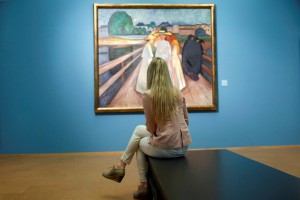 The other day, I was asked to talk to a class of architecture students who had been given a museum as a studio project. Although architects refer to museums as “public buildings,” they are public in a peculiar way, I told them. I illustrated this by comparing a museum to a theater. In a theater, being part of the audience is an integral part of the experience: the more people the better. In fact, a half-empty theater diminishes one’s enjoyment of the play. Being in a museum is different: the more people you have to share it with, the worse the experience. Being in a museum first thing in the morning, before the crowds appear, is marvelous; lining up in a jostling crowd to have your twenty seconds in front of the Mona Lisa is a caricature of museum-going. For at its heart, the museum experience is intensely private, just you and the painting. At the same time, the museum is a public institution, and the challenge for the architect is to manage the transition, from the time you enter to that quiet moment, standing in front of the work of art. The Guggenheim in New York is a poor museum because the transition is too abrupt: you have a split second between gazing at the spiraling ramps and the void, and turning to look at the art. The early-twentieth-century museum handled it much better. The transition occurred as you climbed the grand staircase; at the bottom you were in the crowded lobby; by the time you reached the top you had left that behind you, literally, and were ready to enter the galleries. Kahn, at the Center for British Art at Yale, understood. You enter a tall empty space with only glimpses of the galleries, then you climb the stair inside a confined concrete cylinder, then, finally, you are in the quiet rooms with the paintings.
The other day, I was asked to talk to a class of architecture students who had been given a museum as a studio project. Although architects refer to museums as “public buildings,” they are public in a peculiar way, I told them. I illustrated this by comparing a museum to a theater. In a theater, being part of the audience is an integral part of the experience: the more people the better. In fact, a half-empty theater diminishes one’s enjoyment of the play. Being in a museum is different: the more people you have to share it with, the worse the experience. Being in a museum first thing in the morning, before the crowds appear, is marvelous; lining up in a jostling crowd to have your twenty seconds in front of the Mona Lisa is a caricature of museum-going. For at its heart, the museum experience is intensely private, just you and the painting. At the same time, the museum is a public institution, and the challenge for the architect is to manage the transition, from the time you enter to that quiet moment, standing in front of the work of art. The Guggenheim in New York is a poor museum because the transition is too abrupt: you have a split second between gazing at the spiraling ramps and the void, and turning to look at the art. The early-twentieth-century museum handled it much better. The transition occurred as you climbed the grand staircase; at the bottom you were in the crowded lobby; by the time you reached the top you had left that behind you, literally, and were ready to enter the galleries. Kahn, at the Center for British Art at Yale, understood. You enter a tall empty space with only glimpses of the galleries, then you climb the stair inside a confined concrete cylinder, then, finally, you are in the quiet rooms with the paintings.
On Culture and Architecture
